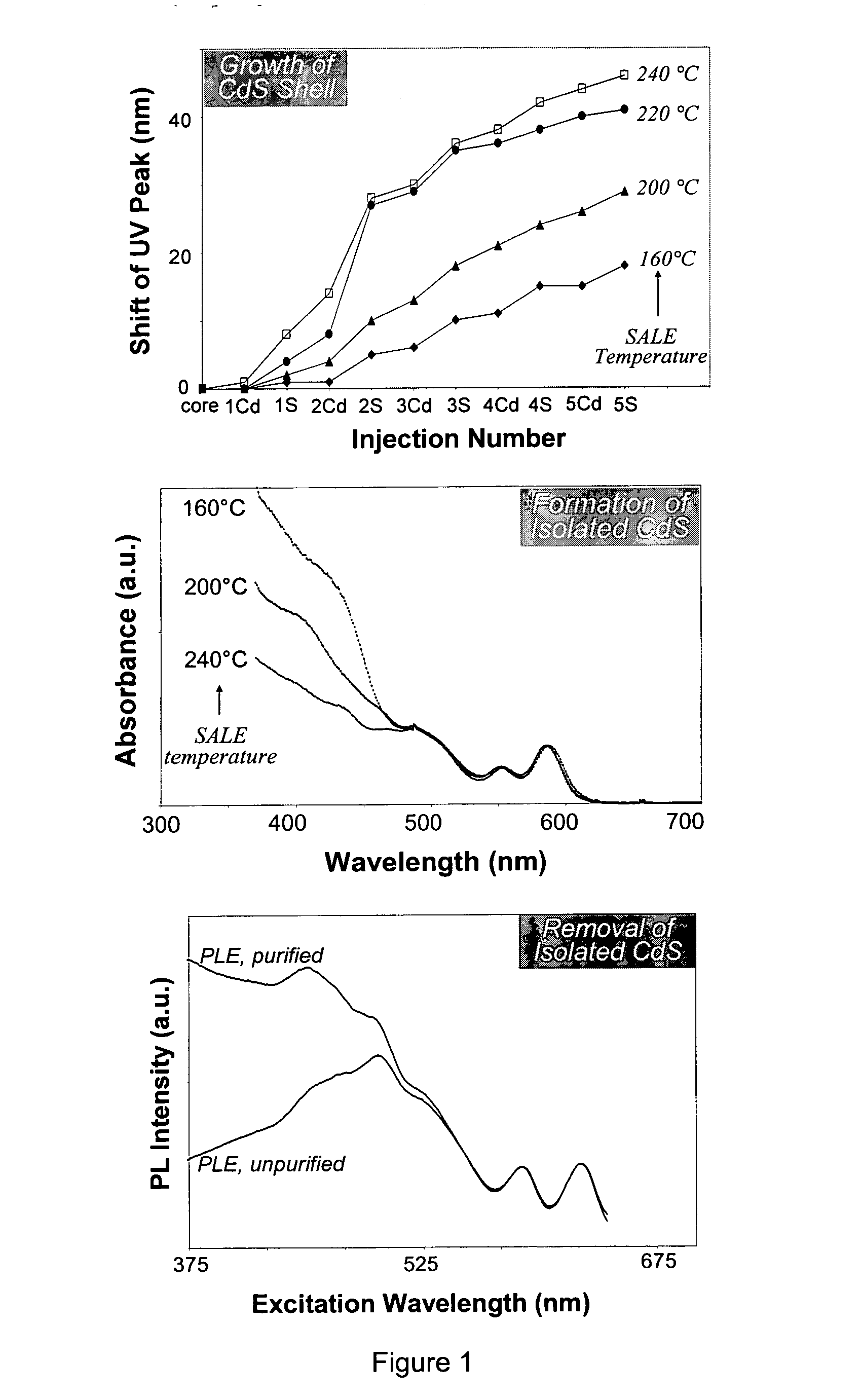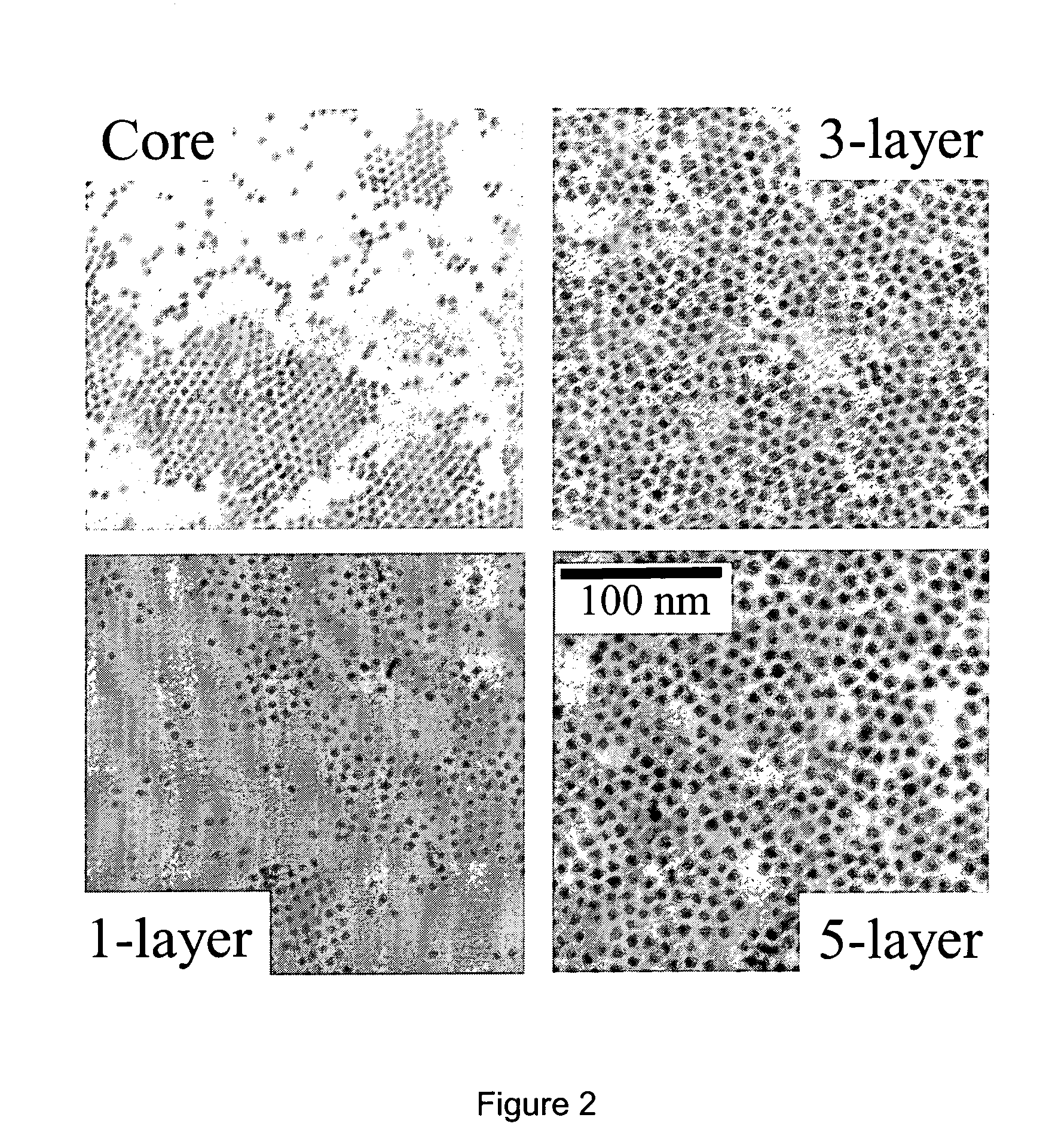Monodisperse core/shell and other complex structured nanocrystals and methods of preparing the same
- Summary
- Abstract
- Description
- Claims
- Application Information
AI Technical Summary
Benefits of technology
Problems solved by technology
Method used
Image
Examples
example 1
Synthesis of CdSe Core Nanocrystals
[0388] Highly fluorescent CdSe nanocrystals were prepared as described in the following typical reaction. A mixture of 0.2 mmol (25.6 mg) of CdO, 0.8 mmol (227 mg) of stearic acid, and 2 g of ODE was prepared in a 25 mL, three-necked flask, and this mixture was heated to about 200° C. to form a clear, colorless solution. The solution was then cooled to room temperature, and 1.5 g of ODA and 0.5 g of TOPO were subsequently added. Under an argon flow, this mixture was reheated to 280° C. A selenium stock solution, prepared by dissolving 2 mmol (158 mg) of Se in 0.472 g of TBP and diluting the solution with 1.37 g of ODE, was quickly injected at this injection temperature of 280° C. The mixture was then maintained at the growth temperature of 250° C. until the desired size of the nanocrystals was obtained.
[0389] This reaction generated CdSe nanocrystals of about 3.5 nm in size, characterized by having a first absorption peak around 570 nm. The reac...
example 2
Synthesis of Cadmium (Cation Precursor) and Sulfur (Anion Precursor) Injection Solutions
[0390] Synthesis of the cadmium sulfide shell material for various core / shell nanocrystals, for example, the CdSe / CdS core / shell nanocrystals, was accomplished at relatively low temperatures by using the following injection solutions for the cation precursor cadmium and the anion precursor sulfur, respectively. The cadmium injection solution (0.04 M) was prepared by dissolving CdO (0.615 g) in oleic acid (OA, 10.83 g), and 1-octadecene (ODE, 108 mL), at 250° C. The sulfur injection solution (0.04 M) was prepared by dissolving sulfur in ODE at 200° C. Both injection solutions were prepared under an argon flow. After clear solutions were obtained, the cadmium injection solution was allowed to cool to about 60° C. for use, while the sulfur injection solution was allowed to cool to room temperature for use. For each injection, a calculated amount of a given injection solution was taken with a syrin...
example 3
Calculations for the Injection Procedure Using the Cadmium and Sulfur Injection Solutions
[0391] The successive ionic layer adsorption and reaction (SILAR) technique employed herein, also termed the solution atomic layer epitaxy (SALE) technique, was based on the alternating injections of the cation injection solution and the anion injection solution, into a solution containing the core nanocrystals. For example, as applied to the growth of CdSe / CdS core / shell nanocrystals, the SILAR technique disclosed herein was based on the alternating injections of the Cd injection solution and the S injection solution, into a solution containing CdSe nanocrystals.
[0392] The amount of cadmium or sulfur, and hence the amount of injection solution, needed for each layer was determined by calculating the number of surface atoms of a given sized core / shell nanocrystal. Since there is only about a 5-6% lattice mismatch between CdSe and CdS bulk crystals, the calculations were based on the wurtzite ...
PUM
| Property | Measurement | Unit |
|---|---|---|
| Fraction | aaaaa | aaaaa |
| Fraction | aaaaa | aaaaa |
| Fraction | aaaaa | aaaaa |
Abstract
Description
Claims
Application Information
 Login to View More
Login to View More - R&D
- Intellectual Property
- Life Sciences
- Materials
- Tech Scout
- Unparalleled Data Quality
- Higher Quality Content
- 60% Fewer Hallucinations
Browse by: Latest US Patents, China's latest patents, Technical Efficacy Thesaurus, Application Domain, Technology Topic, Popular Technical Reports.
© 2025 PatSnap. All rights reserved.Legal|Privacy policy|Modern Slavery Act Transparency Statement|Sitemap|About US| Contact US: help@patsnap.com



